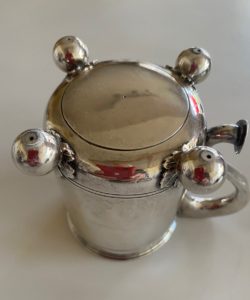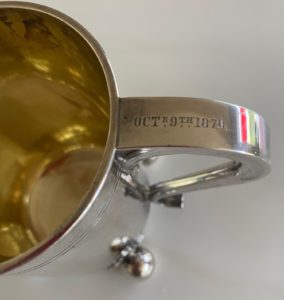 JH sent me a silver christening mug from London, and she told me her husband’s family’s grand patriarch was ALSO a JH. Because the engraving on this christening mug reads “JH” the family purchased it and brought It back to America many years ago.
JH sent me a silver christening mug from London, and she told me her husband’s family’s grand patriarch was ALSO a JH. Because the engraving on this christening mug reads “JH” the family purchased it and brought It back to America many years ago.
British silver markings are difficult to understand because SO many exist. I leave it up to the statisticians among you to figure out how many ways four marks can be attributed. Generally, the marks can be read in this order: First, one mark, generally a “lion passant” (if London silver- the primary center for silver) “guardant,” certifying silver Quality. Second you will see the maker’s mark, identifying the silversmith, who presents the piece to the assay offices. Here I need to stop. What are the assay offices In Britain? From the 16th century on, an office which certified the AMOUNT of silver in a silver piece.
An Important Development in the History of Silver
 Without this ancient ‘guild’ of the silversmiths, and the office that oversaw them, we would have NO sterling silver. The assayer judged Every piece on a mathematically relative scale. Silver is a combination of metals, and NOT ALL silver is sterling, which contains 925 percent silver in 1,000 percent. Silversmiths combine that 925 percent with various OTHER metals. Thus, the assay office oversaw monitoring. LAWS in England specified that pieces brought to the market should be “assayed.”
Without this ancient ‘guild’ of the silversmiths, and the office that oversaw them, we would have NO sterling silver. The assayer judged Every piece on a mathematically relative scale. Silver is a combination of metals, and NOT ALL silver is sterling, which contains 925 percent silver in 1,000 percent. Silversmiths combine that 925 percent with various OTHER metals. Thus, the assay office oversaw monitoring. LAWS in England specified that pieces brought to the market should be “assayed.”
The next marking shows a DATE letter, in a cycle of 20 letters of the alphabet in different shapes, used to identify a year in which the silversmith presented the piece to the assayer. Here I need to stop AGAIN, because in no other country were the regulations as strict for silver as in Britain, which set the standard for silver quality. America used no such grouping of makings, so we had no way of identifying the PLACE, the SILVER MAKER, the DATE, and the QUALITY.
The fourth mark on British silver, called an identity mark, the assay office places to certify the payment of DUTY, required for centuries on silver objects. One reasons for added value attached to silver objects: people who purchased knew what they got, and what QUALITY of silver (amount in the piece).
JH, your husband’s family might have purchased this in the famous SILVER VAULTS in London. Dealers there could read this hallmark in a minute. For me to decipher it, took a few hours:
Sterling or not?
 The piece isn’t actually sterling but Sheffield Plate, a wonderful and resonant combination of silver and copper. At his repair shop in the 18th century Thomas Boulsover discovered this technique, a poor man’s version of sterling. He easily fused a larger sheet of copper between two of the thinnest sheets of silver. These pieces have their own hallmarking system, one of which I found that matches YOURS.
The piece isn’t actually sterling but Sheffield Plate, a wonderful and resonant combination of silver and copper. At his repair shop in the 18th century Thomas Boulsover discovered this technique, a poor man’s version of sterling. He easily fused a larger sheet of copper between two of the thinnest sheets of silver. These pieces have their own hallmarking system, one of which I found that matches YOURS.
You might think Sheffield Silver less valuable than Sterling but that’s NOT the case, because many people LOVE the glow of the orange copper showing through. Collectors say, ‘peeking through’ the silver, and repeated polishing brings this out. It tarnished differently as well, and that’s what I see on the feet of your little christening mug.
The date mark on yours in an “O” in a distinctive “antique” style. Therefore I put the date, at its creation, of 1869, and that makes sense as the initials of the baby gifted this mug was born October 9, 1878.
Because Sheffield pieces of this date have FOUR marks like hallmarked English Sterling, many people mistakenly think their Sheffield pieces are Sterling. However, later Sheffield pieces, post 1890, don’t show the four hallmarks and are simply stamped “Sheffield”, with a “sovereign” head. This signifies the assay office ascertained the silver content in the piece.
Christening Mug Interesting Design
The ball feet are set off by the acorn leaves, quite appropriate in a christening mug: “the ACORN doesn’t fall far from the tree” is the spirit of that design. Because of the pristine condition of the mug, I put the value at $300.
Pingback: Provenance and Tall Tales of Your Treasures - Elizabeth Appraisals